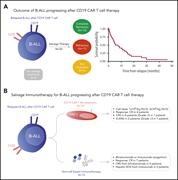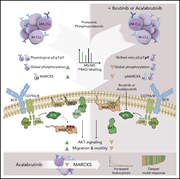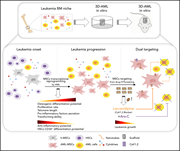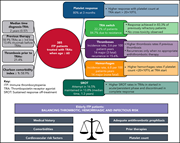Issue Archive
Table of Contents
BLOOD COMMENTARIES
PLENARY PAPER
Genetic identification of patients with AML older than 60 years achieving long-term survival with intensive chemotherapy
CME
Clinical Trials & Observations
Fit older patients with acute myeloid leukemia (AML) are often offered treatment with standard chemotherapy, but it is not clear how many benefit from intensive therapy. In a Plenary Paper that is also this month's CME article, Itzykson and colleagues sequenced AML-associated somatic mutations in 471 older patients treated with standard intensive chemotherapy. They developed a simple prognostic model, based on cytogenetics and somatic mutations in 7 genes, that identifies 3 prognostic groups; the decision tool can guide decisions governing intensive therapy.
HOW I TREAT
How I incorporate novel agents into the treatment of classical Hodgkin lymphoma
Brentuximab vedotin and anti-PD-1 antibodies have changed the treatment landscape for classical Hodgkin lymphoma (cHL). Using 3 illustrative cases, Epperla and Herrera discuss how they integrate these therapies in the treatment of cHL.
CLINICAL TRIALS AND OBSERVATIONS
Interventions and outcomes of adult patients with B-ALL progressing after CD19 chimeric antigen receptor T-cell therapy
Clinical Trials & Observations
Wudhikarn and colleagues report on the outcomes of 38 patients progressing after CD19 chimeric antiget receptor (CAR) T-cell therapy for relapsed or refractory B-cell acute lymphoblastic leukemia (B-ALL). CAR T-cell therapy induced remission in over 80% of adults with relapsed or refractory B-ALL, but relapse was common. Relapsed patients had a median survival of 7.5 months despite further therapy, with most dying of progressive leukemia or toxicity, highlighting the need for novel therapies for this patient population.
LYMPHOID NEOPLASIA
MARCKS affects cell motility and response to BTK inhibitors in CLL
Beckmann et al report on phosphoproteomic analysis of immunoglobulin heavy-chain variable gene (IGHV)—mutated and unmutated chronic lymphocytic leukemia (CLL) cells to provide insight into response to Bruton tyrosine kinase (BTK) inhibitors. The 2 groups showed striking differences, with unmutated CLL (UM-CLL) having higher basal phosphorylation levels than mutated CLL. The study focused on MARCKS, which is much more highly expressed and phosphorylated in UM-CLL and modulates cell migration, perhaps explaining the higher treatment-induced leukocytosis and decreased nodal disease in UMCLL when exposed to BTK inhibitors.
MYELOID NEOPLASIA
Targeting the plasticity of mesenchymal stromal cells to reroute the course of acute myeloid leukemia
Borella et al investigated the cross talk between pediatric AML cells and the bone marrow niche. They demonstrate that AML cells reprogram mesenchymal stromal cells (MSCs) within the niche and modulate their transcriptional pathways to facilitate leukemia cell expansion. In an in vitro 3-dimensional niche implanted in mice, suppressing MSCs in combination with chemotherapy acted synergistically to suppress AML cell proliferation.
PLATELETS AND THROMBOPOIESIS
Real-world use of thrombopoietin receptor agonists in older patients with primary immune thrombocytopenia
Clinical Trials & Observations
Palandri and colleagues reviewed the outcomes of 384 patients over age 60 treated with thrombopoietin receptor agonists (TRAs) for primary immune thrombocytopenia (ITP). Responses to eltrombopag and romiplostim were achieved in 74% to 80% of patients, with sustained responses in 67% and sustained responses off therapy in a small fraction (13.8%). Thromboses (9%) were associated with prior thrombosis history. TRAs are safe and effective in older patients, but patients with a history of thrombosis need appropriate antithrombotic therapy.
BLOOD WORK
CONTINUING MEDICAL EDUCATION (CME) QUESTIONS
-
Cover Image
Cover Image
![issue cover]()
Heterotypic nanotubes that interconnected primary leukemia cells (red, labeled with Vybrant-DiI) and mesenchymal stromal cells (green, calcein-AM) when cocultured in a humanized 3-dimensional scaffold of hydroxyapatite/collagen (gray signal). See the article by Borella et al on page 557.
- PDF Icon Front MatterFront Matter
- PDF Icon Table of ContentsTable of Contents
- PDF Icon Back MatterBack Matter
- PDF Icon Editorial BoardEditorial Board
Advertisement intended for health care professionals
Email alerts
Advertisement intended for health care professionals









A slow-go prognosis for older patients with newly diagnosed AML